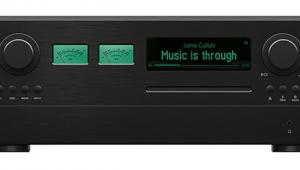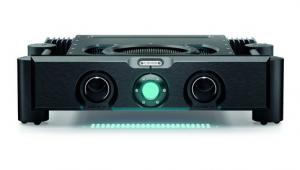Rotel Rsx 1560 Hd Av Receiver (£1850)
After 45 years in business Rotel has every right to do things its own way. The new RSX-1560 gloriously raises its middle knob to the herd, eschewing games of specification trumps and symphony-length features lists. It is also thoroughly gorgeous to behold, and you can’t say that about many of today’s AV receivers. The clean fascia, sturdy case and chunky polished corner pieces give it high-end panache while the rear panel is a cornucopia of beautifully crafted gold plated terminals. I couldn’t make my mind up which way round to place it on the rack.
There is no auto set-up, no convoluted EQ systems, no DSP modes designed to recreate the acoustics of Mahler’s mother’s pantry and none of those fancy user interfaces that look like an Xbox game. It is certainly not lacking in the essentials of a modern AV home hub though; seven channels powered by B&O’s Class D ICEpower modules, plenty of install features, HDMI v1.3 connections and on-board decoding for Dolby TrueHD and DTS-HD Master Audio formats – a first for Rotel. Clearly some serious R&D has gone into Rotel’s new 15-series products, which does beg the question why the remote is a butt-ugly, convoluted flip-up device straight out of ‘Life on Mars’.
FENG SHUI
I didn’t find the Rotel particularly easy to get to grips with operationally but this may be more to do with my familiarity with the aforementioned herd. The vivid blue power light remains on even in standby mode, which caused some confusion, and the naming protocols are wilfully confusing. The Direct button is actually dedicated to FM station access rather than being a direct mode for more pure audio. That feature is left to the Stereo button which on the second or third press goes into Bypass mode – bypassing the DSP.
I might even confess to several minutes changing fuses and frantically poking buttons to bring the beast to life in the first place... before finding the power switch on the back. I must learn to read manuals.
The more I listen to amps incorporating ICEpower modules the more I realise they cannot be pigeonholed into having a certain sound. There is some sort of Class D feng shui at work that elicits different sonic characteristics depending on factors such as how each module is ‘tweaked’, the quality of power supplies and quite possibly your distance from the nearest Druidic ley line. This is no more starkly highlighted in the difference between Rotel’s ICEpower’d RMB-1071 power amp, which I wouldn’t use as a door stop, and this RSX-1560 which is really rather good.
A FLOWING STYLE
With multichannel music from Blu-ray the balance is crisp and natural with masses of space and air in the soundstage. The Legend of Jazz disc may be a demo cliché but there are no complaints at the way the Rotel handles Jane Monheit’s voice with solidity and authority.
There is superb projection, just a hint of natural sibilance and the flowing style is finely articulated. The upright bass really stands out of the mix, each note having a wonderful transient punch while sacrificing none of the inherent warmth of the instrument. As many ICEpower implementations have an ultra-dry bass with all the compassion of a cold rice pudding, the Rotel ’1560 bucks this trend and is nicely full and rounded at the bottom. The live recording of Dave Matthews and Tim Reynolds on Dolby’s demo BD is slightly thick sounding, compressing the soundstage to the front centre. The Rotel does not spare you these shortcomings, highlighting the midrange kerfuffle rather than glossing over it.
There also appears to be a slight tonal difference between the front and centre channels on the RSX-1560, the middle speaker getting a slightly more forward sound that required another –1dB level trim to sit cohesively with the rest of the system. With movies this is a positive benefit as it really brings out the clarity and annunciation of dialogue, and with multichannel music it does lend the sound a realistic front-end solidity that is often lost to the whim of the producer when faced with five channels to play with. Interesting.
More interesting still is the performance with two channel analogue input. In standard mode the analogue signal runs through AD converters, gets molested in the DSPs, and then changed back to analogue at the output stage. The balance is every bit as crisp and spacious as with multichannel sound and my presence test track, Beverley Craven’s ‘Promise Me’, comes through with flying colours and a few goosebumps for good measure.
DITHERING HEIGHTS
This new RSX-1560 is a little cooler sounding than some of its traditionally-amplified peers and there is a hint of glassy-hardness on some recordings, but it is more open and dynamic than most. It is a sound that begs for critical listening, perhaps sacrificing a little soul and tempo for greater detail and accuracy.
Switching to stereo bypass/direct modes in an AV receiver is usually a revelation, but Rotel’s bypass mode came as something of a shock. Suddenly the soundstage lost several metres of width and Beverley Craven’s voice went from ethereal and spacious to extremely focused and firmly positioned in the centre stage. My gut reaction to the ’1560’s bypass mode was not particularly favourable – for possibly the first time since DSP and bypass/direct modes were invented.
After extended listening I had dithered over my preference like a woman in a shoe shop. For ages I swapped back and forth, trading the stilettos of a lighter balance and more open soundstage against the kitten-heels of greater richness and rock solid focus. I did what most men would do anyway – buy both and let the occasion determine the choice.
VERDICT
Bang up to date with Dolby TrueHD and DTS-HD Master Audio decoding, Rotel’s RSX-1560 is pretty straightforward to set up and unencumbered by superfluous features. The clean and uncluttered styling is highly refreshing, too. With its open, crisp and highly detailed sound the ’1560 positively encourages critical listening to new and familiar recordings alike.
Originally published in the April 2009 issue


















































